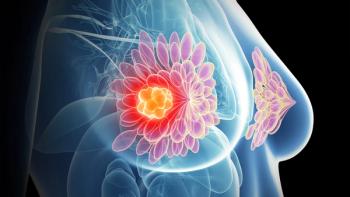
Breast Cancer Staging Manual Revised to Highlight Role of Tumor Biology
The latest revision of the staging manual for breast cancer from the American Joint Committee on Cancer (AJCC) codifies advanced knowledge of the role of biologic factors in cancer.
The latest revision of the staging manual for breast cancer from the American Joint Committee on Cancer (AJCC) codifies advanced knowledge of the role of biologic factors in cancer. It is a great leap forward toward precision oncology, advocates and designers told attendees at the 2018 Miami Breast Cancer Conference® (MBCC).
“We’ve gone from just looking at the tumor, node, and metastatic categories to really looking at the complex biology of the tumor to stage our patients,” said Elizabeth A. Mittendorf, MD, PhD, who served on the panel that revised the AJCC staging system. Mittendorf directs the Breast Immuno-Oncology Program at Dana-Farber/Brigham and Women’s Cancer Center.
Mittendorf and others said the weight of biologic data pointed toward the need for a revision of the AJCC manual and a move away from staging based solely on tumor extent (T), nodal involvement (N), and metastasis (M). Tumor grade, hormone receptors, and HER2 status influence prognosis and justify the update, according to the authors of a poster study presented at the MBCC.1
The centerpiece of the AJCC revision is a prognostic table that incorporates clinical staging—to guide initial treatment and allow for staging of all patients with breast cancer regardless of the sequence of treatment—and pathologic staging—for patients whose initial cancer treatment is surgical resection. “Incorporation of the additional information makes the staging more accurate for prognostic and predictive purposes and helps avoid over- and undertreatment of patients,” according to Yardley et al.1
A staging system has multiple purposes—to determine the extent of disease, inform prognosis, and in many cases to determine a treatment plan—but AJCC planners have also stressed the importance of the common language it provides for enabling the transfer of essential clinical information. In this respect, the TNM staging has been effective, “but breast tumor biology is critically important,” Mittendorf said.
TNM data for patients may be identical, but not biological subtypes and outcomes. Mittendorf cited a study of patients with primary breast cancer, stages I to IV, identified in the California Cancer Registry. “What we found was the difference based on subtype actually became greater the higher stage of disease.”
For patients classified with stage T2N0 disease, 5-year breast cancer specific survival according to subtype was 96%, HR+/HER2-; 94% HR+/HER2+; 92% HER2+/HR-; and 88% triple-negative breast cancer (TNBC). For a stage IV group in the same study, the rates were 47%, HR+/HER2-; 39%, HR+/HER2+; 24%, HER2+/HR-; and 17%, TNBC.2
Scarcity of Level 1 Evidence
A key difficulty was the scarcity of level I evidence to justify the addition of biologic factors to the manual. In developing a workable system, the AJCC expert panel began by assigning points to biologic factors such as pathologic stage, nuclear grade, and ER status. This was externally validated with SEER information. However, an initial point model was built with retrospective data, treatment was not assigned, and the potential for coding errors existed.
This led to models based on biologic scores and risk. The risk score model assigned an AJCC anatomic stage and followed with a risk score based on tumor biology, such as grade, ER status, and HER2 status. “Based on risk score, we could better stratify patients within each stage. What was interesting to me was the stratification was most refined as we got up into the higher stages of disease,” Mittendorf said.
The prognostic stage group in the eighth edition of the staging manual incorporates grade, ER, PR, and HER2 status in addition to TNM categories. Multigene panels are also advised when available.
With respect to the inclusion of genomic data, level I evidence came from the TAILORx study,3 which evaluated whether the expression of genes associated with recurrence among women with early-stage breast cancer could help determine the most effective treatment. Study findings supported the use of a 21-gene panel test to identify a low-risk subset of patients who can be spared postsurgical chemotherapy.
In the 5-year analysis, overall survival was high for low-risk patients. “Arm A of the study involved use of aromatase inhibitors and tamoxifen. This is the arm that had the low recurrence score less than 11, and patients only got hormonal therapy, and the overall survival was 98%. So, basically, any patient who is node negative, ER positive, HER2 negative—if they have a recurrence score less than 11, then they’re going to be stage IA [in the new AJCC prognostic staging system]. All these patients who were previously stage IB, 2A, 2B, 3A—all of them—if they had a recurrence score that was less than 11 would now be classified as being stage 1A,” Mittendorf said.
As noted by Yardley et al in their MBCC poster,1 the lower staging merely means a better overall outlook. “Assignment of a lower stage using the prognostic stage group table does not indicate that a patient can forgo systemic therapy. Instead, it indicates that with appropriate therapy based on both tumor biology and the anatomic extent of disease, the patient has a better prognosis,” the authors wrote.
There are imperfections with the AJCC manual, Mittendorf said. “The pathologic prognostic stage is not applicable to patients receiving neoadjuvant therapy, and there are questions as to how this will be incorporated into the NCCN guidelines, and what is the impact on clinical trials?” She said better clinical data are needed. The NCCN is actively discussing the issue, but their algorithms already are determined by TNM categories and ER, PR, and HER2, “so, in fact, they may not need to make many substantive changes.” As for clinical trials, Mittendorf said there will need to be revisions in staging.
Adherence Data Essential
Another limitation of the eighth manual was noted in a separate poster presentation at MBCC.4 Although biologic indicators contribute to an accurate prognosis, therapy adherence plays a big role, and data should be properly defined, the authors wrote.
They analyzed adherence among a Denver-area population of patients with breast cancer who underwent lumpectomy and intraoperative radiation therapy. Patients (n = 100) were classified using pathological prognostic staging, and noncompliance was documented among 25 (25%) of patients in the series. They included 6 (86%) of 7 patients in the full cohort who experienced locoregional recurrence. “Therapy adherence was an expectation important to the predictive benefit of this group,” the authors wrote.
“Basically [the study] says that this prognostic system isn’t valid if patients are not taking their recommended therapy. The number of recurrences being reported may not truly reflect the picture of what’s going on,” lead author Barbara S. Schwartzberg, MD, president of Western Surgical Care in Denver, said in an interview with OncLive.
References
- Yardley DA, Le-Petros HC, Hronek J, Edelweiss M, Hurwitz S. Major updates to the American Joint Committee on Cancer (AJCC) 8th edition cancer staging manual for breast cancer: clinical implications for medical oncologists. Presented at: the Miami Breast Cancer Conference®, March 8-11, Miami, Florida. Abstract 613.
- Chavez-MacGregor M, Mittendorf EA, Clarke CA, Lichtensztajn DY, Hunt KK, Giordano SH. Incorporating tumor characteristics to the American Joint Committee on Cancer breast cancer staging system. Oncologist. 2017;22(11):1292-1300. doi: 10.1634/theoncologist.2017-0116.
- Sparano JA, Gray RJ, Makower DF, et al. Prospective validation of a 21-gene expression assay in breast cancer. N Engl J Med.2015;373(21):2005-2014. doi: 10.1056/NEJMoa1510764.
- Schwartzberg BS, Miller SA, Paul D. Prognostic benefit of American Joint Commission on Cancer (AJCC) 8th edition breast cancer pathological prognostic stage group in patients treated with intraoperative radiation therapy (IORT) at a single institution in Denver, Colorado. Presented at: the Miami Breast Cancer Conference®, March 8-11, Miami, Florida. Abstract 627.
Newsletter
Knowledge is power. Don’t miss the most recent breakthroughs in cancer care.













































































